Challenges in a Hybrid Fabrication Process to Generate Metallic Polarization Elements with Sub-Wavelength Dimensions
Abstract
1. Introduction
2. Basic Theory of Hollow Waveguides
3. Fabrication
4. Fabrication Challenges
4.1. Weak Adhesion (Part I)
4.2. Sticking and Inhibition Layer
4.3. Weak Adhesion (Part II)
5. Optical Experiments
6. Conclusions
Author Contributions
Funding
Conflicts of Interest
References
- Gottmann, J.; Hermans, M.; Repiev, N.; Ortmann, J. Selective Laser-Induced Etching of 3D Precision Quartz Glass Components for Microfluidic Applications—Up-Scaling of Complexity and Speed. Micromachines 2017, 8, 110. [Google Scholar] [CrossRef]
- Roth, G.L.; Esen, C.; Hellmann, R. Circular microchannels inside bulk polymethylmethacrylate generated by femtosecond laser using slit beam shaping. J. Laser Appl. 2019, 31, 022603. [Google Scholar] [CrossRef]
- Mirza, I.; Bulgakova, N.M.; Tomáštík, J.; Michálek, V.; Haderka, O.; Fekete, L.; Mocek, T. Ultrashort pulse laser ablation of dielectrics: Thresholds, mechanisms, role of breakdown. Sci. Rep. 2016, 6, 39133. [Google Scholar] [CrossRef] [PubMed]
- Žemaitis, A.; Gečys, P.; Barkauskas, M.; Račiukaitis, G.; Gedvilas, M. Highly-efficient laser ablation of copper by bursts of ultrashort tuneable (fs-ps) pulses. Sci. Rep. 2019, 9, 12280. [Google Scholar] [CrossRef] [PubMed]
- Gruner, A.; Naumann, L.; Schille, J.; Loeschner, U. High Pulse Repetition Frequency Micro Hole Drilling of Silicon Using Ultrashort Pulse Laser Radiation. J. Laser Micro Nanoeng. 2019, 14, 190–197. [Google Scholar]
- Shen, N.; Bude, J.D.; Ly, S.; Keller, W.J.; Rubenchik, A.M.; Negres, R.; Guss, G. Enhancement of laser material drilling using high-impulse multi-laser melt ejection. Opt. Express 2019, 27, 19864–19886. [Google Scholar] [CrossRef] [PubMed]
- Riveiro, A.; Quintero, F.; Boutinguiza, M.; Val, J.D.; Comesaña, R.; Lusquiños, F.; Pou, J. Laser Cutting: A Review on the Influence of Assist Gas. Materials 2019, 12, 157. [Google Scholar] [CrossRef]
- Anghel, C.; Gupta, K.; Jen, T.C. Analysis and optimization of surface quality of stainless steel miniature gears manufactured by CO2 laser cutting. Optik 2020, 203, 164049. [Google Scholar] [CrossRef]
- Schwarz, S.; Rung, S.; Esen, C.; Hellmann, R. Fabrication of a high-quality axicon by femtosecond laser ablation and CO2 laser polishing for quasi-Bessel beam generation. Opt. Express 2018, 26, 23287–23294. [Google Scholar] [CrossRef]
- Brenner, A.; Osbild, M.; Finger, J. Ultrafast Laser Structuring within a Process Chain - Influence of the Surface Morphology. J. Laser Micro Nanoeng. 2019, 14, 198–205. [Google Scholar]
- Melchels, F.P.; Feijen, J.; Grijpma, D.W. A review on stereolithography and its applications in biomedical engineering. Biomaterials 2010, 31, 6121–6130. [Google Scholar] [CrossRef] [PubMed]
- Huang, J.; Qin, Q.; Wang, J. A review of stereolithography: Processes and systems. Processes 2020, 8, 1138. [Google Scholar] [CrossRef]
- Wüst, P.; Edelmann, A.; Hellmann, R. Areal Surface Roughness Optimization of Maraging Steel Parts Produced by Hybrid Additive Manufacturing. Materials 2020, 13, 418. [Google Scholar] [CrossRef] [PubMed]
- Majchrowicz, K.; Pakieła, Z.; Brynk, T.; Romelczyk-Baishya, B.; Płocińska, M.; Kurzynowski, T.; Chlebus, E. Microstructure and mechanical properties of Ti–Re alloys manufactured by selective laser melting. Mater. Sci. Eng. A 2019, 765, 138290. [Google Scholar] [CrossRef]
- Zhang, J.; Song, B.; Wei, Q.; Bourell, D.; Shi, Y. A review of selective laser melting of aluminum alloys: Processing, microstructure, property and developing trends. J. Mater. Sci. Technol. 2019, 35, 270–284. [Google Scholar] [CrossRef]
- Fina, F.; Goyanes, A.; Gaisford, S.; Basit, A.W. Selective laser sintering (SLS) 3D printing of medicines. Int. J. Pharm. 2017, 529, 285–293. [Google Scholar] [CrossRef]
- Sing, S.L.; Yeong, W.Y.; Wiria, F.E.; Tay, B.Y.; Zhao, Z.; Zhao, L.; Tian, Z.; Yang, S. Direct selective laser sintering and melting of ceramics: A review. Rapid Prototyp. J. 2017, 23, 611–623. [Google Scholar] [CrossRef]
- Dobbelstein, H.; Gurevich, E.L.; George, E.P.; Ostendorf, A.; Laplanche, G. Laser metal deposition of a refractory TiZrNbHfTa high-entropy alloy. Addit. Manuf. 2018, 24, 386–390. [Google Scholar] [CrossRef]
- Carluccio, D.; Bermingham, M.; Kent, D.; Demir, A.G.; Previtali, B.; Dargusch, M.S. Comparative Study of Pure Iron Manufactured by Selective Laser Melting, Laser Metal Deposition, and Casting Processes. Adv. Eng. Mater. 2019, 21, 1900049. [Google Scholar] [CrossRef]
- Kawata, S.; Sun, H.B.; Tanaka, T.; Takada, K. Finer features for functional microdevices. Nature 2001, 412, 697–698. [Google Scholar] [CrossRef]
- Malinauskas, M.; Farsari, M.; Piskarskas, A.; Juodkazis, S. Ultrafast laser nanostructuring of photopolymers: A decade of advances. Phys. Rep. 2013, 533, 1–31. [Google Scholar] [CrossRef]
- Gissibl, T.; Thiele, S.; Herkommer, A.; Giessen, H. Two-photon direct laser writing of ultracompact multi-lens objectives. Nat. Photon. 2016, 10, 554–560. [Google Scholar] [CrossRef]
- Zyla, G.; Kovalev, A.; Grafen, M.; Gurevich, E.L.; Esen, C.; Ostendorf, A.; Gorb, S. Generation of bioinspired structural colors via two-photon polymerization. Sci. Rep. 2017, 7, 17622. [Google Scholar] [CrossRef] [PubMed]
- Trautmann, A.; Rüth, M.; Lemke, H.D.; Walther, T.; Hellmann, R. Two-photon polymerization based large scaffolds for adhesion and proliferation studies of human primary fibroblasts. Opt. Laser Technol. 2018, 106, 474–480. [Google Scholar] [CrossRef]
- Cao, H.Z.; Zheng, M.L.; Dong, X.Z.; Jin, F.; Zhao, Z.S.; Duan, X.M. Two-photon nanolithography of positive photoresist thin film with ultrafast laser direct writing. Appl. Phys. Lett. 2013, 102, 201108. [Google Scholar] [CrossRef]
- Ma, Z.C.; Zhang, Y.L.; Han, B.; Chen, Q.D.; Sun, H.B. Femtosecond-Laser Direct Writing of Metallic Micro/ Nanostructures: From Fabrication Strategies to Future Applications. Small Methods 2018, 2, 1700413. [Google Scholar] [CrossRef]
- Gansel, J.K.; Thiel, M.; Rill, M.S.; Decker, M.; Bade, K.; Saile, V.; von Freymann, G.; Linden, S.; Wegener, M. Gold helix photonic metamaterial as broadband circular polarizer. Science 2009, 325, 1513–1515. [Google Scholar] [CrossRef]
- Wendy Gu, X.; Greer, J.R. Ultra-strong architected Cu meso-lattices. Extrem. Mech. Lett. 2015, 2, 7–14. [Google Scholar] [CrossRef]
- Grigorescu, A.E.; Hagen, C.W. Resists for Sub-20-nm Electron Beam Lithography with a Focus on HSQ: State of the Art. Nanotechnology 2009, 20, 292001. [Google Scholar] [CrossRef]
- She, A.; Zhang, S.; Shian, S.; Clark, D.R.; Capasso, F. Large area metalenses: Design, characterization, and mass manufacturing. Opt. Express 2018, 26, 1573–1585. [Google Scholar] [CrossRef]
- Ni, H.; Yuan, G.; Sun, L.; Chang, N.; Di, Z.; Chen, R.; Jiang, L.; Chen, H.; Gu, Z.; Zhao, X. Large-scale high-numerical-aperture super-oscillatory lens fabricated by direct laser writing lithography. RSC Adv. 2018, 8, 20117–20123. [Google Scholar] [CrossRef]
- Bohling, M.; Seiler, T.; Wdowiak, B.; Jahns, J.; Mohr, J.; Börner, M. Highly precise micro-retroreflector array fabricated by the LIGA process and its application as tapped delay line filter. Appl. Opt. 2012, 51, 5989–5995. [Google Scholar] [CrossRef] [PubMed][Green Version]
- Helfert, S.F.; Edelmann, A.; Jahns, J. Hollow waveguides as polarization converting elements: A theoretical study. J. Eur. Opt. Soc. 2015, 10, 15006. [Google Scholar] [CrossRef]
- Helfert, S.F.; Seiler, T.; Jahns, J.; Becker, J.; Jakobs, P.; Bacher, A. Numerical simulation of hollow waveguide arrays as polarization converting elements and experimental verification. Opt. Quantum Electron. 2017, 49, 313. [Google Scholar] [CrossRef]
- Belle, S.; Helfert, S.F.; Hellmann, R.; Jahns, J. Hollow waveguide array with subwavelength dimensions as a space-variant polarization converter. J. Opt. Soc. Am. B 2019, 36, D119–D125. [Google Scholar] [CrossRef]
- Khan, M.Z.H.; Nakanishi, T.; Osaka, T. Effects of chemical treatment of indium tin oxide electrode on its surface roughness and work function. Surf. Coat. Technol. 2014, 244, 189–193. [Google Scholar] [CrossRef]
- Kang, J.W.; Lee, S.P.; Kim, D.G.; Lee, S.; Lee, G.H.; Kim, J.K.; Park, S.Y.; Kim, J.H.; Kim, H.K.; Jeong, Y.S. Reduction of Series Resistance in Organic Photovoltaic Using Low Sheet Resistance of ITO Electrode. ECS Solid State Lett. 2009, 12, H64. [Google Scholar] [CrossRef]
- Wang, D.H.; Kyaw, A.K.K.; Gupta, V.; Bazan, G.C.; Heeger, A.J. Enhanced Efficiency Parameters of Solution- Processable Small-Molecule Solar Cells Depending on ITO Sheet Resistance. Adv. Energy Mater. 2013, 3, 1161–1165. [Google Scholar] [CrossRef]
- Choi, M.; Jo, K.; Yang, H. Effect of Different Pretreatments on Indium-Tin Oxide Electrodes. Bull. Korean. Chem. Soc. 2013, 34, 421–425. [Google Scholar] [CrossRef][Green Version]
- Yu, H.Y.; Feng, X.D.; Grozea, D.; Lu, Z.H.; Sodhi, R.N.S.; Hor, A.M.; Aziz, H. Surface electronic structure of plasma-treated indium tin oxides. Appl. Phys. Lett. 2001, 78, 2595–2597. [Google Scholar] [CrossRef]
- Han, D.M.; Lee, J.H.; Jeong, K.H.; Lee, J.G. Effects of substrate bias power on the surface of ITO electrodes during O2/CF4 plasma treatment and the resulting performance of organic light-emitting diodes. Met. Mater. Int. 2010, 16, 627–632. [Google Scholar] [CrossRef]
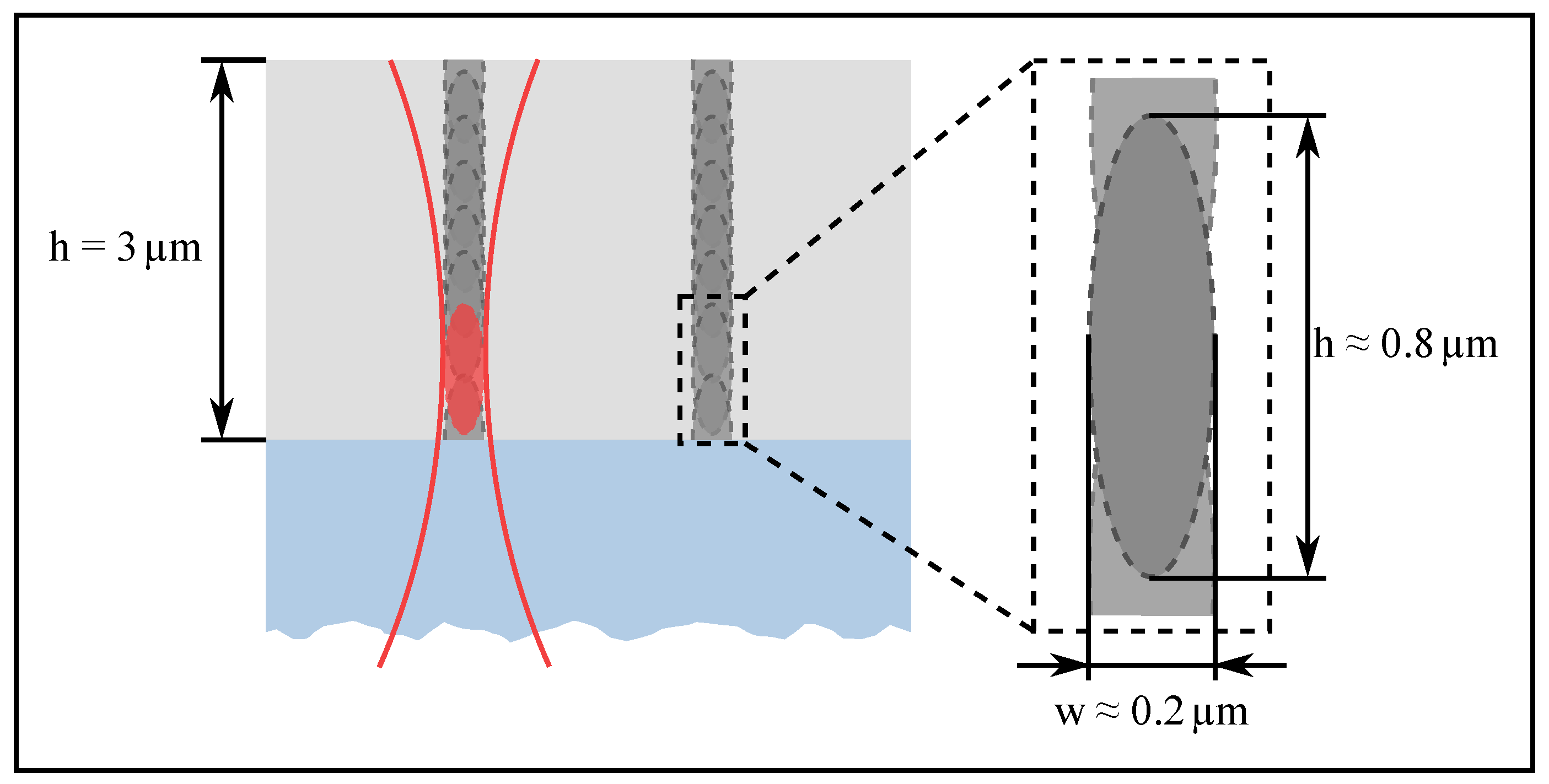
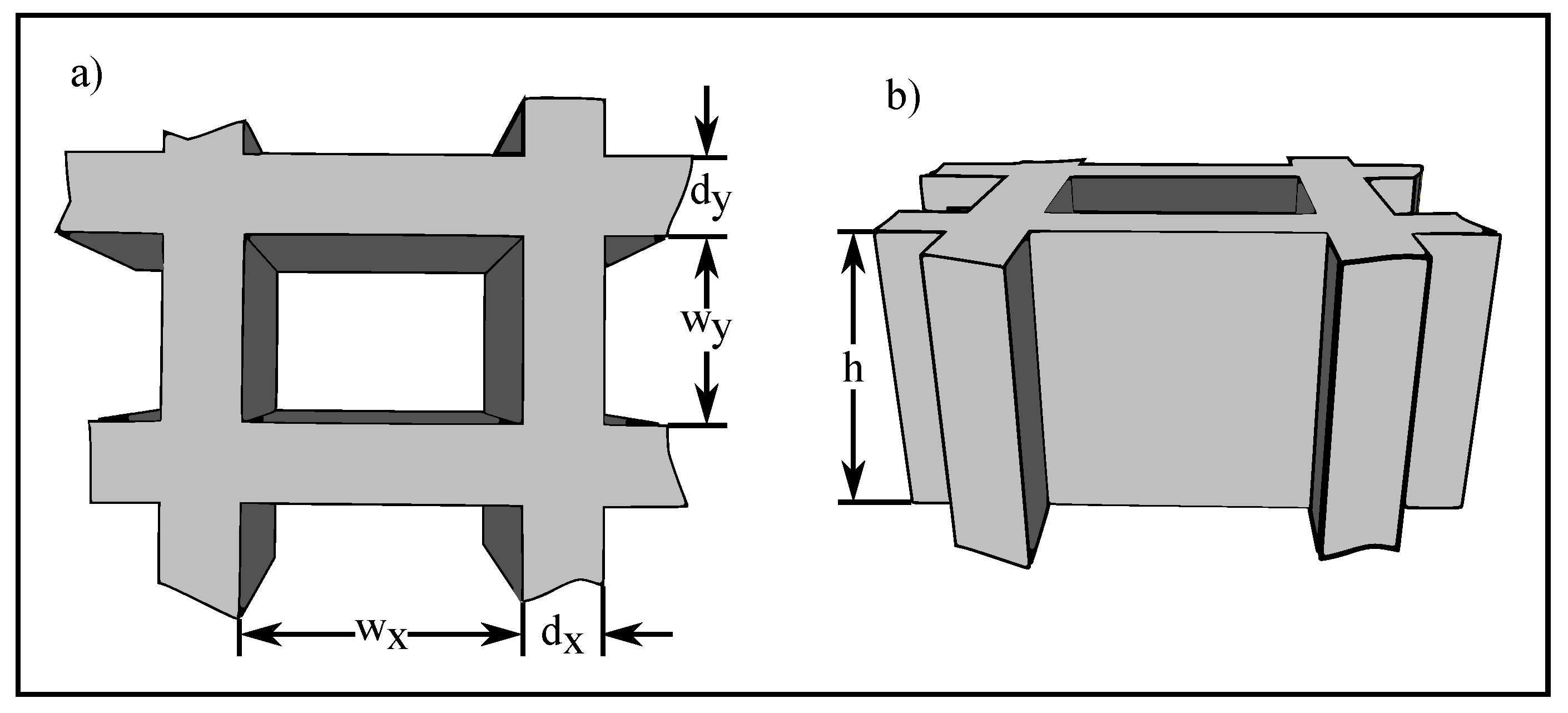

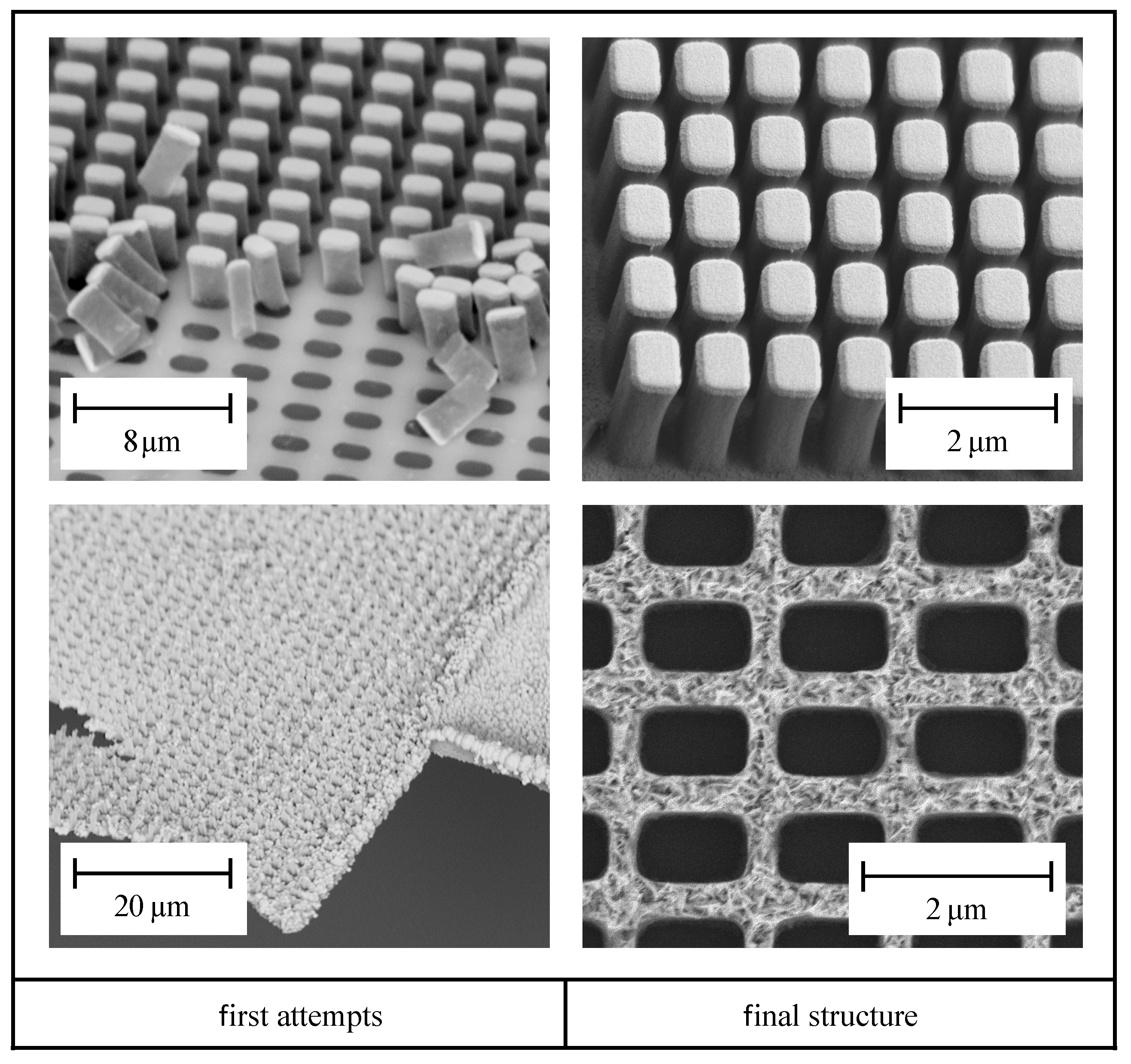
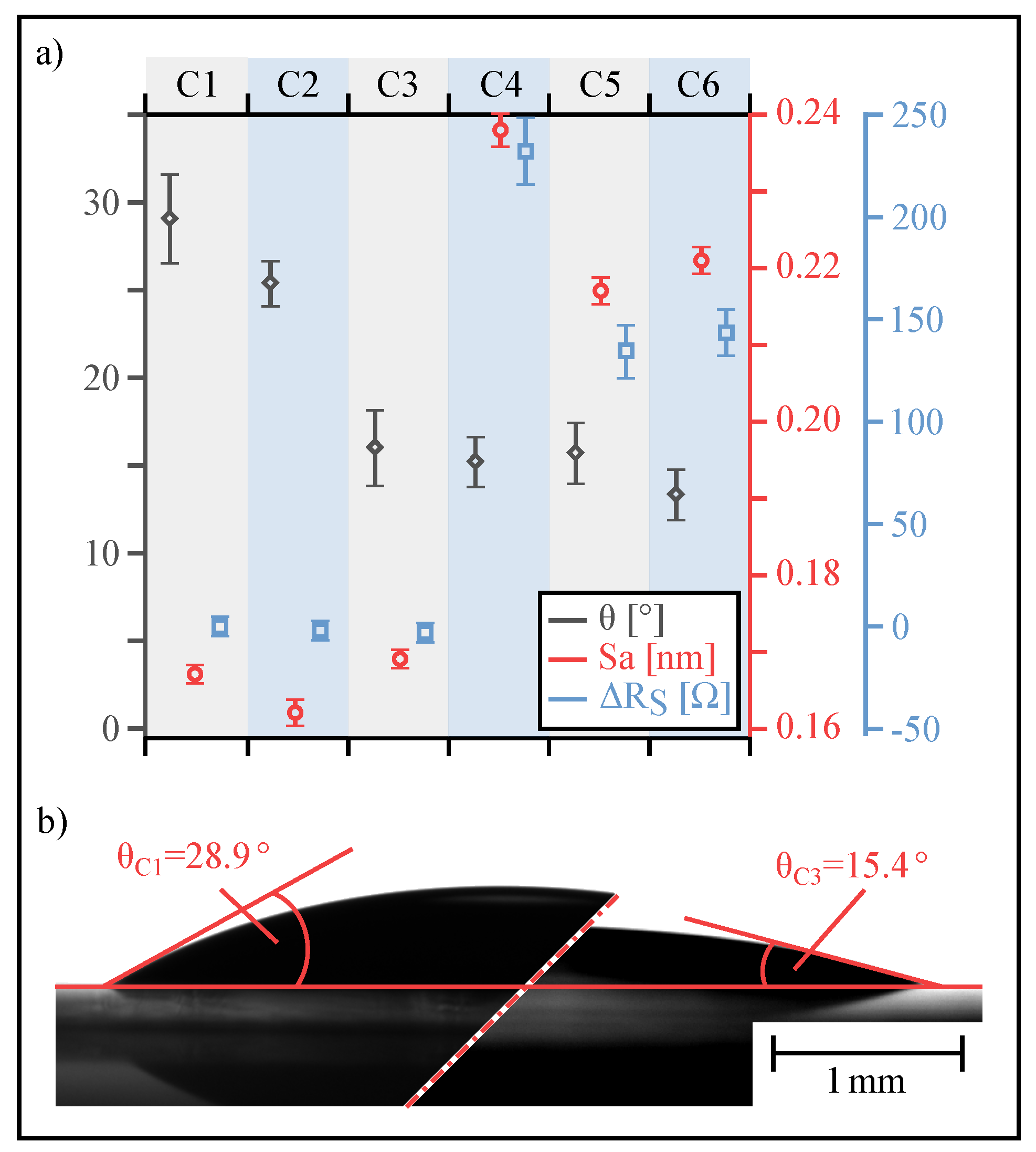
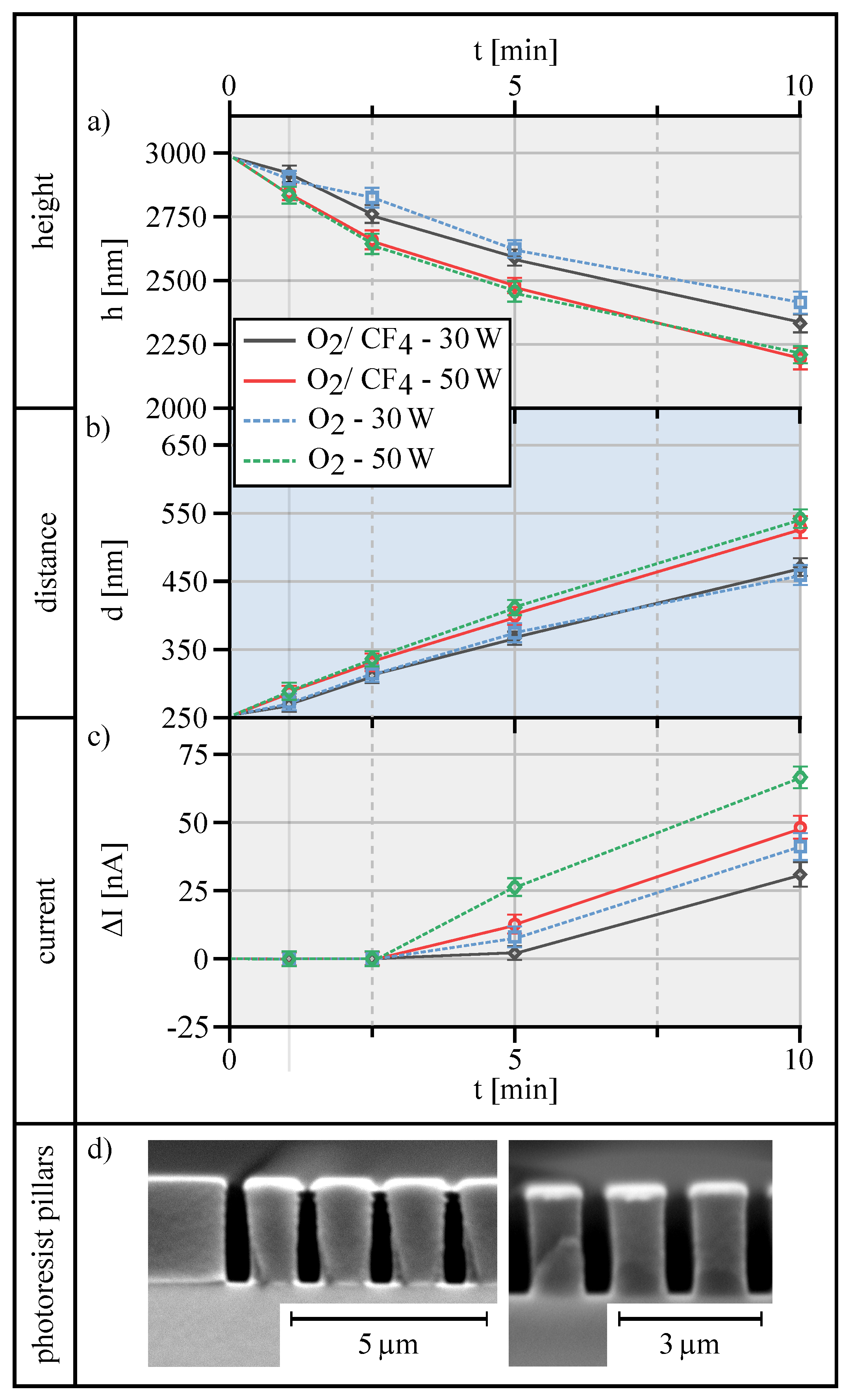
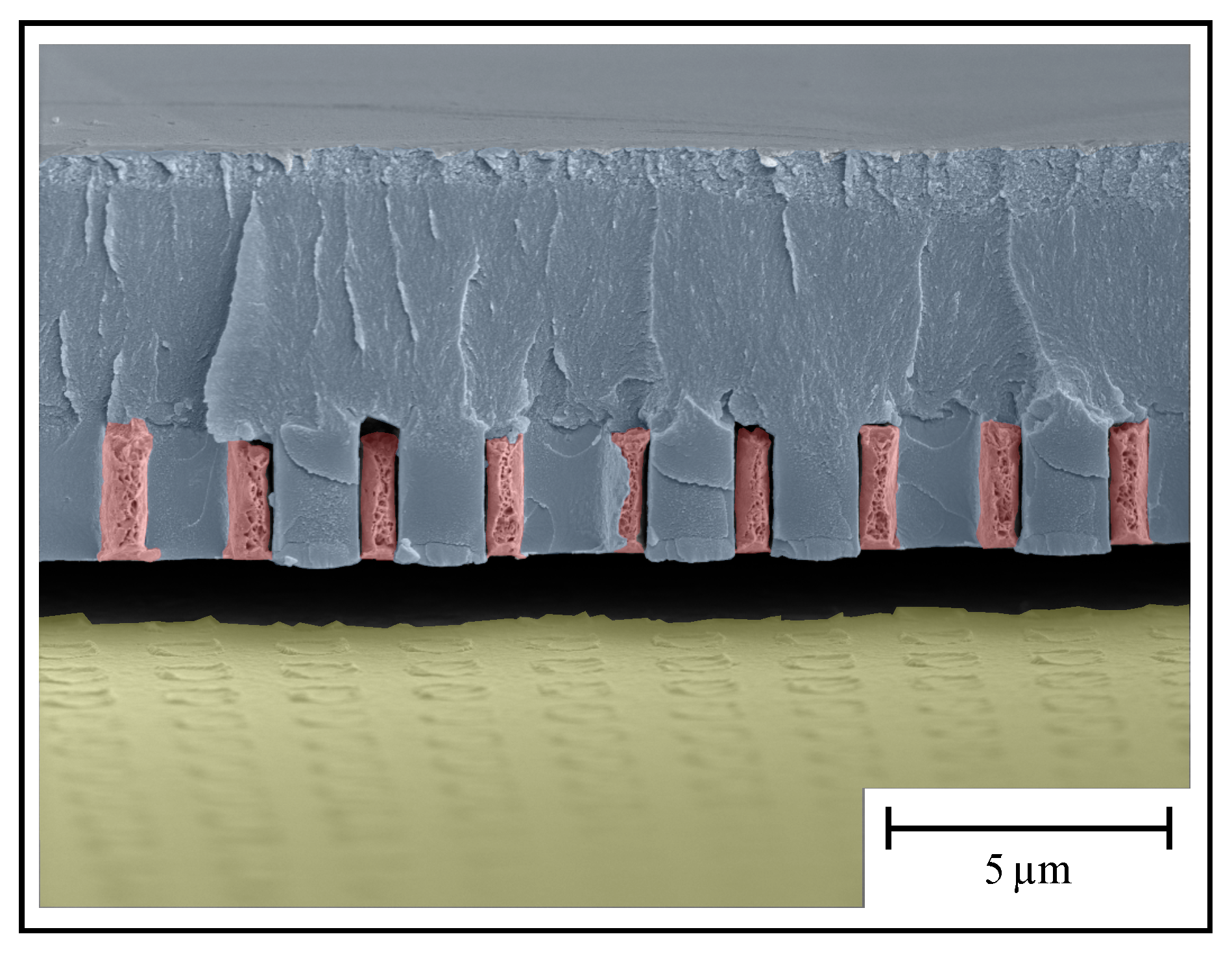

Publisher’s Note: MDPI stays neutral with regard to jurisdictional claims in published maps and institutional affiliations. |
© 2020 by the authors. Licensee MDPI, Basel, Switzerland. This article is an open access article distributed under the terms and conditions of the Creative Commons Attribution (CC BY) license (http://creativecommons.org/licenses/by/4.0/).
Share and Cite
Belle, S.; Goetzendorfer, B.; Hellmann, R. Challenges in a Hybrid Fabrication Process to Generate Metallic Polarization Elements with Sub-Wavelength Dimensions. Materials 2020, 13, 5279. https://doi.org/10.3390/ma13225279
Belle S, Goetzendorfer B, Hellmann R. Challenges in a Hybrid Fabrication Process to Generate Metallic Polarization Elements with Sub-Wavelength Dimensions. Materials. 2020; 13(22):5279. https://doi.org/10.3390/ma13225279
Chicago/Turabian StyleBelle, Stefan, Babette Goetzendorfer, and Ralf Hellmann. 2020. "Challenges in a Hybrid Fabrication Process to Generate Metallic Polarization Elements with Sub-Wavelength Dimensions" Materials 13, no. 22: 5279. https://doi.org/10.3390/ma13225279
APA StyleBelle, S., Goetzendorfer, B., & Hellmann, R. (2020). Challenges in a Hybrid Fabrication Process to Generate Metallic Polarization Elements with Sub-Wavelength Dimensions. Materials, 13(22), 5279. https://doi.org/10.3390/ma13225279




